[English] 日本語
 Yorodumi
Yorodumi- PDB-7dpz: Cryo-EM structure of Coxsackievirus B1 virion in complex with CAR -
+ Open data
Open data
- Basic information
Basic information
| Entry | Database: PDB / ID: 7dpz | ||||||
|---|---|---|---|---|---|---|---|
| Title | Cryo-EM structure of Coxsackievirus B1 virion in complex with CAR | ||||||
 Components Components |
| ||||||
 Keywords Keywords |  VIRUS / Coxsackievirus B1 / VIRUS / Coxsackievirus B1 /  CAR / CAR /  Cryo-EM Cryo-EM | ||||||
| Function / homology |  Function and homology information Function and homology informationAV node cell-bundle of His cell adhesion involved in cell communication / cell adhesive protein binding involved in AV node cell-bundle of His cell communication / homotypic cell-cell adhesion / AV node cell to bundle of His cell communication / epithelial structure maintenance / gamma-delta T cell activation / regulation of AV node cell action potential / germ cell migration / apicolateral plasma membrane / cell-cell junction organization ...AV node cell-bundle of His cell adhesion involved in cell communication / cell adhesive protein binding involved in AV node cell-bundle of His cell communication / homotypic cell-cell adhesion / AV node cell to bundle of His cell communication / epithelial structure maintenance / gamma-delta T cell activation / regulation of AV node cell action potential / germ cell migration / apicolateral plasma membrane / cell-cell junction organization / transepithelial transport /  connexin binding / cardiac muscle cell development / heterophilic cell-cell adhesion via plasma membrane cell adhesion molecules / symbiont-mediated suppression of host cytoplasmic pattern recognition receptor signaling pathway via inhibition of RIG-I activity / bicellular tight junction / connexin binding / cardiac muscle cell development / heterophilic cell-cell adhesion via plasma membrane cell adhesion molecules / symbiont-mediated suppression of host cytoplasmic pattern recognition receptor signaling pathway via inhibition of RIG-I activity / bicellular tight junction /  intercalated disc / intercalated disc /  picornain 2A / picornain 2A /  cell adhesion molecule binding / symbiont-mediated suppression of host mRNA export from nucleus / mitochondrion organization / symbiont genome entry into host cell via pore formation in plasma membrane / cell adhesion molecule binding / symbiont-mediated suppression of host mRNA export from nucleus / mitochondrion organization / symbiont genome entry into host cell via pore formation in plasma membrane /  neutrophil chemotaxis / neutrophil chemotaxis /  picornain 3C / acrosomal vesicle / picornain 3C / acrosomal vesicle /  filopodium / T=pseudo3 icosahedral viral capsid / filopodium / T=pseudo3 icosahedral viral capsid /  PDZ domain binding / host cell cytoplasmic vesicle membrane / Cell surface interactions at the vascular wall / PDZ domain binding / host cell cytoplasmic vesicle membrane / Cell surface interactions at the vascular wall /  adherens junction / adherens junction /  neuromuscular junction / cytoplasmic vesicle membrane / endocytosis involved in viral entry into host cell / neuromuscular junction / cytoplasmic vesicle membrane / endocytosis involved in viral entry into host cell /  beta-catenin binding / beta-catenin binding /  viral capsid / viral capsid /  : / Immunoregulatory interactions between a Lymphoid and a non-Lymphoid cell / cell-cell junction / nucleoside-triphosphate phosphatase / : / Immunoregulatory interactions between a Lymphoid and a non-Lymphoid cell / cell-cell junction / nucleoside-triphosphate phosphatase /  integrin binding / virus receptor activity / protein complex oligomerization / integrin binding / virus receptor activity / protein complex oligomerization /  cell junction / cell junction /  cell body / monoatomic ion channel activity / cell body / monoatomic ion channel activity /  heart development / heart development /  growth cone / actin cytoskeleton organization / basolateral plasma membrane / defense response to virus / growth cone / actin cytoskeleton organization / basolateral plasma membrane / defense response to virus /  RNA helicase activity / RNA helicase activity /  DNA replication / neuron projection / induction by virus of host autophagy / symbiont entry into host cell / DNA replication / neuron projection / induction by virus of host autophagy / symbiont entry into host cell /  RNA-directed RNA polymerase / RNA-directed RNA polymerase /  membrane raft / symbiont-mediated suppression of host gene expression / viral RNA genome replication / cysteine-type endopeptidase activity / membrane raft / symbiont-mediated suppression of host gene expression / viral RNA genome replication / cysteine-type endopeptidase activity /  RNA-dependent RNA polymerase activity / RNA-dependent RNA polymerase activity /  signaling receptor binding / DNA-templated transcription / host cell nucleus / virion attachment to host cell / structural molecule activity / signaling receptor binding / DNA-templated transcription / host cell nucleus / virion attachment to host cell / structural molecule activity /  ATP hydrolysis activity / protein-containing complex / ATP hydrolysis activity / protein-containing complex /  proteolysis / proteolysis /  extracellular space / extracellular space /  RNA binding / extracellular region / RNA binding / extracellular region /  nucleoplasm / nucleoplasm /  ATP binding / identical protein binding / ATP binding / identical protein binding /  metal ion binding / metal ion binding /  plasma membrane / plasma membrane /  cytoplasm cytoplasmSimilarity search - Function | ||||||
| Biological species |   Coxsackievirus B1 Coxsackievirus B1  Homo sapiens (human) Homo sapiens (human) | ||||||
| Method |  ELECTRON MICROSCOPY / ELECTRON MICROSCOPY /  single particle reconstruction / single particle reconstruction /  cryo EM / Resolution: 3.8 Å cryo EM / Resolution: 3.8 Å | ||||||
 Authors Authors | Li, S. / Zhu, R. / Xu, L. / Cheng, T. / Zheng, Q. | ||||||
 Citation Citation |  Journal: Cell Host Microbe / Year: 2021 Journal: Cell Host Microbe / Year: 2021Title: Cryo-EM structures reveal the molecular basis of receptor-initiated coxsackievirus uncoating. Authors: Longfa Xu / Qingbing Zheng / Rui Zhu / Zhichao Yin / Hai Yu / Yu Lin / Yuanyuan Wu / Maozhou He / Yang Huang / Yichao Jiang / Hui Sun / Zhenghui Zha / Hongwei Yang / Qiongzi Huang / Dongqing ...Authors: Longfa Xu / Qingbing Zheng / Rui Zhu / Zhichao Yin / Hai Yu / Yu Lin / Yuanyuan Wu / Maozhou He / Yang Huang / Yichao Jiang / Hui Sun / Zhenghui Zha / Hongwei Yang / Qiongzi Huang / Dongqing Zhang / Zhenqin Chen / Xiangzhong Ye / Jinle Han / Lisheng Yang / Che Liu / Yuqiong Que / Mujin Fang / Ying Gu / Jun Zhang / Wenxin Luo / Z Hong Zhou / Shaowei Li / Tong Cheng / Ningshao Xia /   Abstract: Enterovirus uncoating receptors bind at the surface depression ("canyon") that encircles each capsid vertex causing the release of a host-derived lipid called "pocket factor" that is buried in a ...Enterovirus uncoating receptors bind at the surface depression ("canyon") that encircles each capsid vertex causing the release of a host-derived lipid called "pocket factor" that is buried in a hydrophobic pocket formed by the major viral capsid protein, VP1. Coxsackievirus and adenovirus receptor (CAR) is a universal uncoating receptor of group B coxsackieviruses (CVB). Here, we present five high-resolution cryoEM structures of CVB representing different stages of virus infection. Structural comparisons show that the CAR penetrates deeper into the canyon than other uncoating receptors, leading to a cascade of events: collapse of the VP1 hydrophobic pocket, high-efficiency release of the pocket factor and viral uncoating and genome release under neutral pH, as compared with low pH. Furthermore, we identified a potent therapeutic antibody that can neutralize viral infection by interfering with virion-CAR interactions, destabilizing the capsid and inducing virion disruption. Together, these results define the structural basis of CVB cell entry and antibody neutralization. | ||||||
| History |
|
- Structure visualization
Structure visualization
| Movie |
 Movie viewer Movie viewer |
|---|---|
| Structure viewer | Molecule:  Molmil Molmil Jmol/JSmol Jmol/JSmol |
- Downloads & links
Downloads & links
- Download
Download
| PDBx/mmCIF format |  7dpz.cif.gz 7dpz.cif.gz | 169.8 KB | Display |  PDBx/mmCIF format PDBx/mmCIF format |
|---|---|---|---|---|
| PDB format |  pdb7dpz.ent.gz pdb7dpz.ent.gz | 138.6 KB | Display |  PDB format PDB format |
| PDBx/mmJSON format |  7dpz.json.gz 7dpz.json.gz | Tree view |  PDBx/mmJSON format PDBx/mmJSON format | |
| Others |  Other downloads Other downloads |
-Validation report
| Arichive directory |  https://data.pdbj.org/pub/pdb/validation_reports/dp/7dpz https://data.pdbj.org/pub/pdb/validation_reports/dp/7dpz ftp://data.pdbj.org/pub/pdb/validation_reports/dp/7dpz ftp://data.pdbj.org/pub/pdb/validation_reports/dp/7dpz | HTTPS FTP |
|---|
-Related structure data
| Related structure data |  30812MC  7dpfC  7dpgC  7dq1C  7dq4C  7dq7C M: map data used to model this data C: citing same article ( |
|---|---|
| Similar structure data |
- Links
Links
- Assembly
Assembly
| Deposited unit | 
|
|---|---|
| 1 | x 60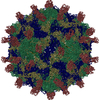
|
| 2 |
|
| 3 | x 5
|
| 4 | x 6
|
| 5 | 
|
| Symmetry | Point symmetry: (Schoenflies symbol : I (icosahedral : I (icosahedral )) )) |
- Components
Components
| #1: Protein |  Virus / VP1 / P1C / P1D Virus / VP1 / P1C / P1DMass: 31207.117 Da / Num. of mol.: 1 / Source method: isolated from a natural source / Source: (natural)   Coxsackievirus B1 / References: UniProt: W8GTF7 Coxsackievirus B1 / References: UniProt: W8GTF7 |
|---|---|
| #2: Protein | Mass: 29122.744 Da / Num. of mol.: 1 / Source method: isolated from a natural source / Source: (natural)   Coxsackievirus B1 / References: UniProt: A0A2S0RQC2 Coxsackievirus B1 / References: UniProt: A0A2S0RQC2 |
| #3: Protein | Mass: 26328.764 Da / Num. of mol.: 1 / Source method: isolated from a natural source / Source: (natural)   Coxsackievirus B1 / References: UniProt: L7UV52 Coxsackievirus B1 / References: UniProt: L7UV52 |
| #4: Protein |  Mass: 7484.246 Da / Num. of mol.: 1 / Source method: isolated from a natural source / Source: (natural)   Coxsackievirus B1 / References: UniProt: A0A2S1FMR1 Coxsackievirus B1 / References: UniProt: A0A2S1FMR1 |
| #5: Protein | Mass: 13471.361 Da / Num. of mol.: 1 / Fragment: D1 domain / Source method: isolated from a natural source / Source: (natural)   Homo sapiens (human) / References: UniProt: P78310 Homo sapiens (human) / References: UniProt: P78310 |
-Experimental details
-Experiment
| Experiment | Method:  ELECTRON MICROSCOPY ELECTRON MICROSCOPY |
|---|---|
| EM experiment | Aggregation state: PARTICLE / 3D reconstruction method:  single particle reconstruction single particle reconstruction |
- Sample preparation
Sample preparation
| Component | Name: Coxsackievirus B1 / Type: VIRUS / Entity ID: all / Source: NATURAL |
|---|---|
| Source (natural) | Organism:   Coxsackievirus B1 Coxsackievirus B1 |
| Details of virus | Empty: YES / Enveloped: NO / Isolate: STRAIN / Type: VIRION |
| Buffer solution | pH: 7.4 |
| Specimen | Embedding applied: NO / Shadowing applied: NO / Staining applied : NO / Vitrification applied : NO / Vitrification applied : YES : YES |
Vitrification | Cryogen name: ETHANE |
- Electron microscopy imaging
Electron microscopy imaging
| Experimental equipment |  Model: Tecnai F30 / Image courtesy: FEI Company |
|---|---|
| Microscopy | Model: FEI TECNAI F30 |
| Electron gun | Electron source : :  FIELD EMISSION GUN / Accelerating voltage: 300 kV / Illumination mode: FLOOD BEAM FIELD EMISSION GUN / Accelerating voltage: 300 kV / Illumination mode: FLOOD BEAM |
| Electron lens | Mode: BRIGHT FIELD Bright-field microscopy Bright-field microscopy |
| Image recording | Electron dose: 25 e/Å2 / Film or detector model: FEI FALCON III (4k x 4k) |
- Processing
Processing
| Software | Name: PHENIX / Version: 1.15.2_3472: / Classification: refinement | ||||||||||||||||||||||||
|---|---|---|---|---|---|---|---|---|---|---|---|---|---|---|---|---|---|---|---|---|---|---|---|---|---|
CTF correction | Type: PHASE FLIPPING AND AMPLITUDE CORRECTION | ||||||||||||||||||||||||
3D reconstruction | Resolution: 3.8 Å / Resolution method: FSC 0.143 CUT-OFF / Num. of particles: 6538 / Symmetry type: POINT | ||||||||||||||||||||||||
| Refine LS restraints |
|
 Movie
Movie Controller
Controller







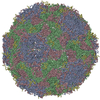
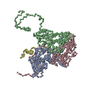
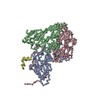
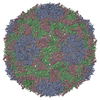
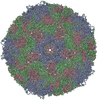
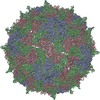
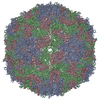
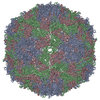
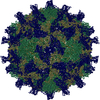
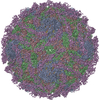
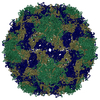
 PDBj
PDBj




